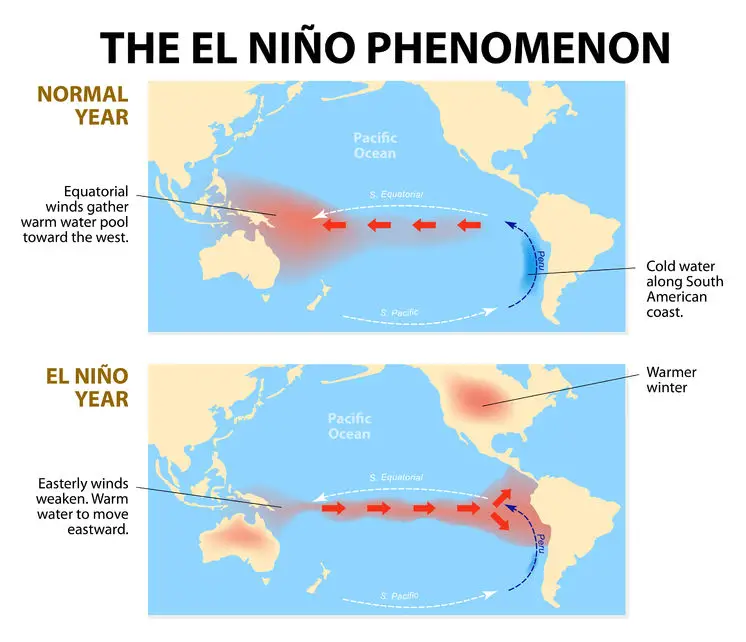El Niño and La Niña are Pacific Ocean climate cycles that can change weather patterns around the world. They are essentially opposites of each other.
Warm water in the western Pacific Ocean shifts eastward toward the west coast of South America, triggering an El Niño, which also features trade winds that are weaker than normal. A similar shift of cold water triggers a La Ni�a, which also features trade winds that are stronger than normal.
 An El Niño or La Niña can occur every two to seven years and can last from several months to a few years. Scientists generally know they're coming because the effects are noticeable beginning in the Northern Hemisphere spring. An El Niño occurs more frequently than a La Niña. A La Niña frequently follows an El Niño; this is not always the case.
An El Niño or La Niña can occur every two to seven years and can last from several months to a few years. Scientists generally know they're coming because the effects are noticeable beginning in the Northern Hemisphere spring. An El Niño occurs more frequently than a La Niña. A La Niña frequently follows an El Niño; this is not always the case.
The two together are part of the El Niño-Southern Oscillation, or ENSO cycle. It's not always one or the other, though: The ENSO cycle has a neutral phase as well. During a neutral phase, trade winds blow westward across the Pacific.
Because an El Niño brings weaker trade winds, surface temperatures of the water off South America warm up, creating more favorable conditions for active tropical storms in the Pacific; as well, weather patterns shift, in that rain and clouds normally associated with warm ocean waters form more to the east than they otherwise would.
Even though El Niño events occur in the Pacific Ocean, they can affect weather patterns in the Atlantic Ocean as well, as more stable air makes it more difficult for hurricanes to come to life.
Scientists have found evidence of El Niño occurrences millions of years ago, in caves, ice cores, sea-bottom mud, and tree rings.
The first written record of an El Niño is thought to be by Peruvian fishermen, who noticed certain warming and rainfall patterns that occurred at Christmastime. The English translation of "El Niño" is "Little Boy"; the first writings referred to "El Niño de Navidad," or the "Little boy of Christmas," a reference to Jesus, whom Christians believe was born on Christmas.
Similarly, La Niña can be translated into English as "Little girl."
Some historians have theorized that El Niño events have affected events further back in history. Peru, on the west coast of South America, is particularly affected by an El Niño event, and some historians think that such an event might have helped to cause a draught that plagued the Inca Empire and, further back, contributed to the demise of the Moche culture.
More recently, scientists now think that an El Niño event in 1789–1793 contributed to agriculture shortages in Europe and potentially helped touch off the unrest that resulted in the French Revolution. In the same way, scientists now think that an El Niño event in 1876–1877 led to a famine that killed millions of people.